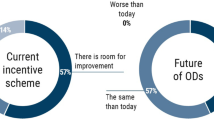Abstract
The origins of clinical genetics services vary throughout Europe with some emerging from paediatric medicine and others from an academic laboratory setting. In 2011, the cross-border patients’ rights directive recommended the creation of European Research Networks (ERNs) to improve patient care throughout EU. In 2013, the EU recommendation on the care for rare diseases came into place. The process of designating EU centres of expertise in rare diseases is being implemented to allow centres to enter ERNs. Hence, this is an opportune time to reflect on the current status of genetic services and research funding throughout Europe as 80 % of rare diseases have a genetic origin. Our aims were to determine (a) whether EU countries are prepared in terms of appropriate clinical genetic staffing to fulfil the European Union Committee of Experts on Rare Diseases (EUCERD) criteria that will allow national centres to be designated as centres of expertise, (b) which EU countries are successful in grant submissions to EU rare disease research funding and (c) country of origin of researchers from the EU presenting their research work as a spoken presentation at the European Society of Human Genetics annual conference. Our results show there is wide disparity of staffing levels per head of population in clinical genetics units throughout Europe. EU rare disease research funding is not being distributed equitably and the opportunity to present research is skewed with many countries not achieving spoken presentations despite abstract submissions. Inequity in the care of patients with rare diseases exists in Europe. Many countries will struggle to designate centres of expertise as their staffing mix and levels will not meet the EUCERD criteria which may prevent them from entering ERNs. The establishment of a small number of centres of expertise centrally, which is welcome, should not occur at the expense of an overall improvement in EU rare disease patient care. Caution should be observed to ensure that the inequity gap that already exists does not widen with the development of ERNs.





Similar content being viewed by others
References
Azzopardi-Muscat N, Brand H (2015) Will European Reference Networks herald a new era of care for patients with rare and complex diseases? Eur J Public Health 25(3):362–3. doi:10.1093/eurpub/cku144, No abstract available
EUROCAT (2015) EUROCAT prevalence tables. Available at EUROCAT Website Database: http://www.eurocat-network.eu/ACCESSPREVALENCEDATA/PrevalenceTables (data uploaded 06/01/2015)
Hamamy H (2012) Consanguineous marriages; preconception consultation in primary health care settings. J Community Genet 3:185–192
Hennekam RC, Biesecker LG (2012) Next-generation sequencing demands next-generation phenotyping. Hum Mutat 33(5):884–6. doi:10.1002/humu.22048
Rodwell C, Aymé S (2014) Report on the state of the art of rare disease activities in Europe 2014. http://www.eucerd.eu/upload/file/Reports/2014ReportStateofArtRDActivities.pdf
Rodwell C, Aymé S.Rare disease policies to improve care for patients in Europe. Biochim Biophys Acta. 2015 Feb 25. pii: S0925-4439(15)00059-9. doi: 10.1016/j.bbadis.2015.02.008.
www.ec.europa.eu/budget/fts: eCORDA (External Common Research Datawarehouse), European Commission, as of 2014/06/20
Yi Y, Lindemann M, Colligs A, Snowball C (2011) Economic burden of neural tube defects and impact of prevention with folic acid: a literature review. Eur J Pediatr 170:1391–400
Acknowledgments
We thank Mr. Chris Russell and Dr. Jillian Casey for their assistance. We thank Jörg Schmidtke for the information on German recommendations on Clinical Genetic staffing requirements. We thank the following for contributing their country’s data: Veselina Gadancheva (Bulgaria), Milan Macek (Czech Republic), Helena Kaarinen (Finland), Stanislas Lyonnet (France), Christine Scholz (Germany), Marleen Kets (Netherlands), Gunnar Houge (Norway), Jorge Sequeiros (Portugal), Ulf Kristoffersson (Sweden), UK data: Carol Gardiner (Scotland), AlexMurray (Wales), Kay Metcalfe (England), Fiona Stewart (Northern Ireland) and Mark Longmuir (UK genetic counsellors).
Author information
Authors and Affiliations
Corresponding author
Ethics declarations
Conflict of interest
Dr. Lynch declares no conflict of interest. Dr. Borg declares no conflict of interest.
Rights and permissions
About this article
Cite this article
Lynch, S.A., Borg, I. Wide disparity of clinical genetics services and EU rare disease research funding across Europe. J Community Genet 7, 119–126 (2016). https://doi.org/10.1007/s12687-015-0256-y
Received:
Accepted:
Published:
Issue Date:
DOI: https://doi.org/10.1007/s12687-015-0256-y




